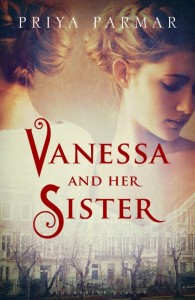No Friend Like a Sister: Priya Parmar Discusses Vanessa and Her Sister
by Sarah Bower
 ‘What is yours, Virginia?’ I asked softly. I too could be dangerous. ‘Do you want to discuss what is yours and what is mine? Do you really?’
‘What is yours, Virginia?’ I asked softly. I too could be dangerous. ‘Do you want to discuss what is yours and what is mine? Do you really?’
Priya Parmar’s second novel, Vanessa and Her Sister (Ballantine US, 2014; Bloomsbury UK, 2015), is an almost impossible feat of storytelling in that its subject matter is the Bloomsbury Set, so notorious and so unnaturally full of household names that the pitfalls of pastiche and lampoon fairly gape before the reckless or unwary writer.
Parmar sidesteps these by focusing on the years 1905 to 1912 in the lives of the Stephen siblings and their circle, using the voice of Vanessa, the sister who expressed herself through painting rather than words and is, therefore, in historical terms, the ‘silent’ sister. Parmar’s novel uses a complex structure, including letters (‘all fictional…but I’m very pleased you asked’), facsimiles of travel documents and telegrams, to punctuate the main narrative, written in the form of Vanessa’s diary.
‘Vanessa was the very centre of the group,’ explains Parmar, ‘but unlike her more famous sister, did not leave a diary behind. I liked the idea of structuring the novel around her reimagined voice. She was clearly a passionate and opinionated woman, but often her letters held back and did not discuss the more tumultuous events of her life. What she did not include in her letters told me so much about who she might have been.’
Although most members of the set make an appearance in the novel – hilariously camp Lytton Strachey, bashful Morgan Forster, Clive Bell who is never quite able to free himself of the restraints of convention – Parmar’s focus is the intense and stormy relationship between Vanessa and Virginia. ‘It was daunting to write about such a glittering set of people,’ Parmar admits. ‘And the long list of characters that did not make it into the novel was equally daunting. I tried to focus on who was an important presence in Vanessa’s life and which characters moved the story forward.’ Vanessa struggles with Virginia’s jealousies, insecurities, and her bouts of mania, at the same time negotiating her own complicated romantic life, building a reputation as a painter and doing her best to be an unfashionably hands-on mother to her two sons. Virginia attempts to shape her sister’s life become brutally clear, and Vanessa’s resistance is complicated by her fierce love for Virginia and her sense of almost parental responsibility for her.
‘Woolf was a once in a generation writer,’ says Parmar. ‘Her prose is so clean and unexpected and lush without ever tipping over into sentiment…cutting and truthful and neat. She is a joy to read.’ That said, ‘the story is very much Vanessa’s. I am always interested in unexpected perspectives of familiar people. It cannot have been easy to have a sister like Virginia Woolf, and the more research I did, the more fascinating Vanessa Bell became.’
Parmar researched the Bloomsbury papers thoroughly, but feels the key to bringing Vanessa to life lies in her having been given unprecedented private access to Vanessa’s home, Charleston Farmhouse. ‘Virginia Nicholson, Vanessa Bell’s granddaughter and an absolutely brilliant social historian and writer, took me to Charleston and showed me the enchanting house. She shared some of her childhood memories of being there and brought the house to magical life. And then she and the wonderful head curator showed me some of Vanessa Bell’s never before seen sketches that have been recently gifted to the Charleston Trust. They are sketches that Vanessa describes in her letters and I had written about in the novel, and to see them was astonishing.’
Parmar writes with feeling and authenticity about art, a skill which she attributes to ‘a dear friend who is a wonderful, wonderful artist. My understanding of how an artist might feel about a work stems from her.’ One thing which unites the sisters in this novel is a deep insecurity about their own work, which does not seem to be shared by the men, even those who would turn out to be less talented than either of the Stephen sisters. A theme emerges of the pressures on women in a man’s world which feels acutely relevant over a hundred years on.
About the contributor: Sarah Bower recently returned from six months in Hong Kong as writer in residence at Lingnan University. Her third novel, Erosion, was published in April 2014, and she just spent a month in Jordan and the occupied West Bank researching her latest book, Love Can Kill People, Can’t It?, set in 1947.
______________________________________________
Published in Historical Novels Review | Issue 71, February 2015






